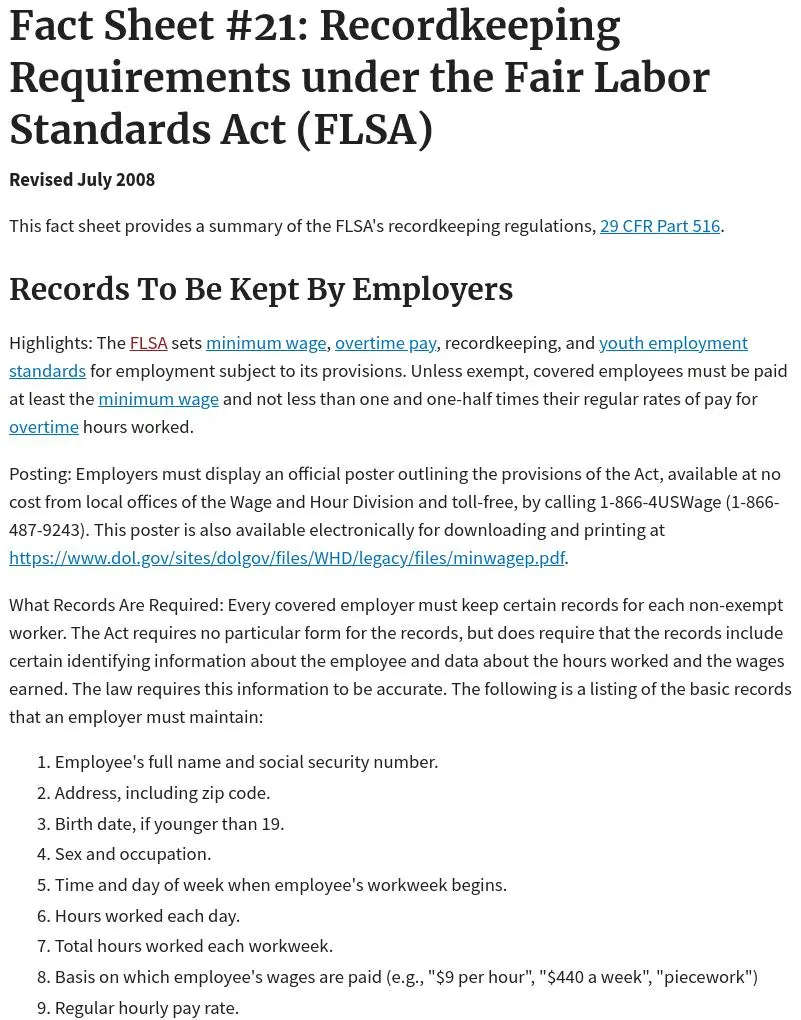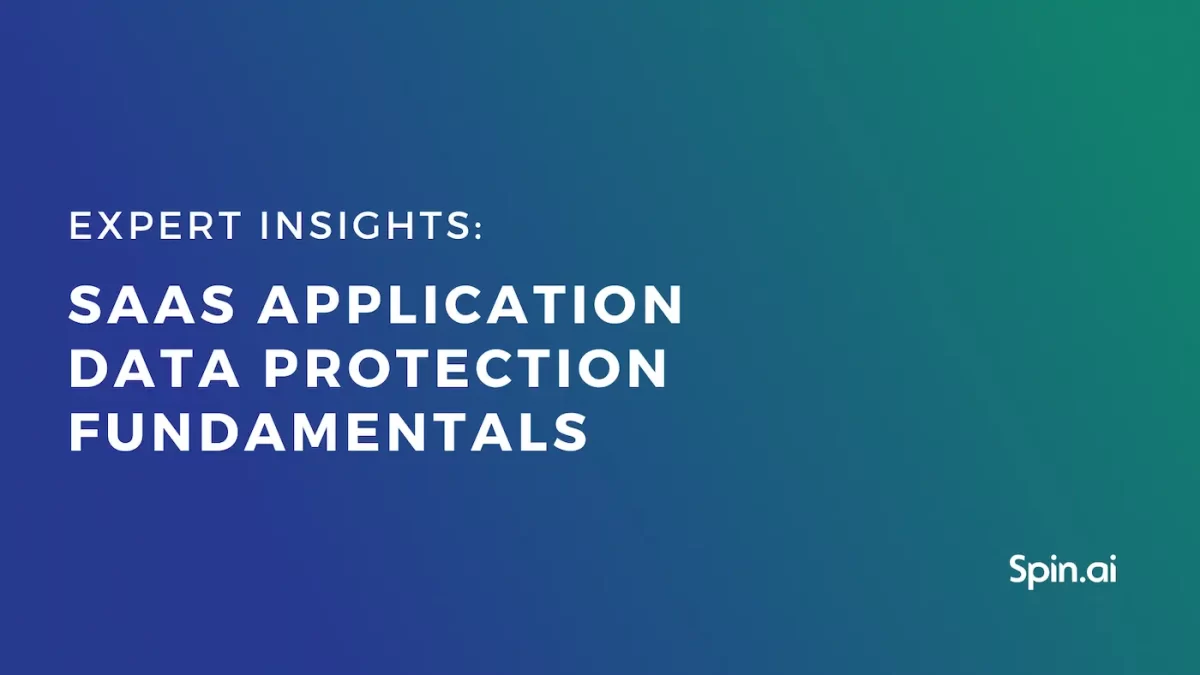What is a Data Retention Policy, and How Do I Create One?

In this blog, we overview the definition of a data retention policy, explain its values, outline best practices, and provide step-by-step guidelines on how to build your own. We’ll also identify the pitfalls you might face and ways to avoid them.
What Is a Data Retention Policy?
In the modern economy, organizations produce overwhelming quantities of data. Amassing it forms two critical issues for any entity.
First, it outgrows storage limitations. Second, it impedes the operation and oversight of information. To address the issues mentioned above, organizations come up against the necessity to get rid of data.
Meanwhile, guided by an effective data retention strategy, a significant portion of documents and files in possession of an organization will remain essential for current and future operations. Finally, companies operate within the law systems that mandate the preservation of particular data.
Summing up, organizations ought to carefully sift out the information to maintain and information to eliminate and then conduct accordingly. They also need to correctly define the timeframes for each activity.
A data retention policy aids entities in managing their data pursuant to the principles:
- Categorize data by their lifecycle (e.g., short, medium, long, permanent)
- Set the procedures for the preservation/erasing of information.
- Delineate the structure and format of data (e.g., folder hierarchy, zip files).
- Identify the storage place for each data type.
- Assign employees in charge of the process.
- Select the instruments to run data retention.
- Summarize the precedent items in one document.
Why is a data retention policy important?
When endeavoring to introduce a data retention policy, a considerable amount of companies confronts a lack of comprehension from their employees, together with the heads of departments and even top management. This list will help you ‘sell’ the idea in your company:
Business Continuity
Apart from controlling the elimination of unneeded information, data retention policies administer the preservation of the necessary one. Identifying what categories of data your organization will require later on and conserving it can protect your business from a halt in operations associated with data loss.
Furthermore, data retention policies stipulate regular backups. Provided an event (usually, it is a cyber event) wipes your records, your business can easily recover vital information and resume its operations.
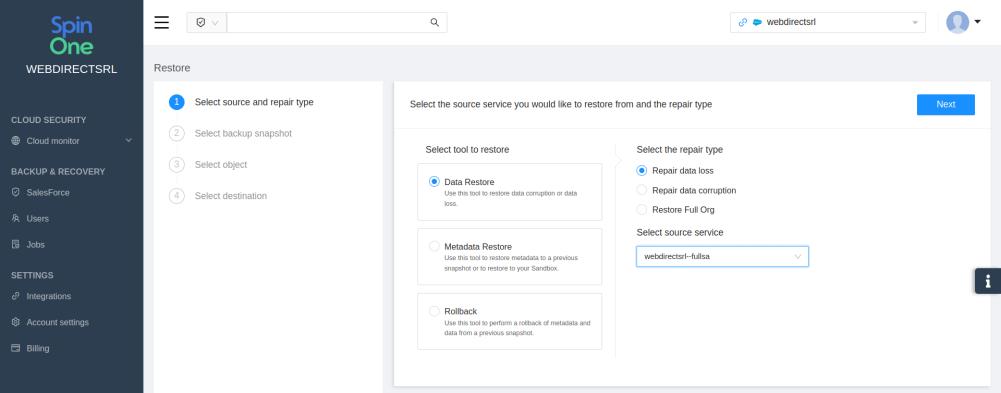
Comply with rules and regulations
Many countries adopt laws that mandate storing particular categories of data for a specified duration. Setting the policies and abiding by them will enable your company to avoid possible negative legal consequences.
Assist dispute settlement
It’s not unheard of that, after receiving a product or a service, customers might experience buying regret. They will attempt to transfer the responsibility for this event onto your business. Luckily, data retention is here to save the day. It’s especially important in legal disputes.
Improve business operations
A valid data retention policy with regular deletions and archiving will keep your information organized, easily discoverable, and up-to-the-minute. Your employees will know where to search for the necessary files in case they need them for work.
Furthermore, think of data drives as workspaces. Many psychologists argued that cluttered workspaces can increase employees’ stress and impact their overall performance. Most of the research was done in relation to the physical spaces. However, their result can be extrapolated to digital environments as most of us feel overwhelmed when seeing the mess in file systems.
Decrease the chances of data leaks
Some disposable data might contain sensitive information. Deleting it decreases the chances for cybercriminals to get their hands on it.
A critical consideration: cybercrime has been growing exponentially for the past 30 years. In many ways, it’s been an arms race between them and IT security. Many companies have increased their data protection in the past years.
However, there’s a significant volume of data protected with outdated methods or forgotten altogether – leaving a massive vulnerability. Make sure your IT team has access to safe data centers like AWS, Azure, or GCP – here are other suggestions:
Avoid unnecessary expenses
All the advantages of data retention policies listed above can also help you avoid a substantial amount of expenses. Your firm can avoid paying fines for law violations or ransom for leaked data or losing revenue due to downtime or low employee performance.
Finally, storage costs stand high. Employ data retention policies to maintain solely necessary information on your drives thus saving Gigabytes of storage. Archiving is another important aspect that decreases the memory space your business uses.
Deliver a unified policy
This statement might sound like a tautology. However, contemplate this. When imposed by top management, a data retention policy delivers a clear set of rules applied to the entirety of the business entity and its data.
You give your employees and your IT team guidelines on in what way and at what moment in time they should exercise particular operations with individual records. It helps avoid chaos and minimize mistakes
How to create data retention policy: a step-by-step guide
So you’ve decided you need a data retention policy. Where do you start?
Understand the legal aspect
Talk to your legal department about rules and regulations that impact your business operations – and gather a list of classes of data subject to preservation.
Take into consideration that there also might be regulations that bound the retention period, or format of data (paper, digital, paper + digital, zip, doc, etc.), the class of storage, and its location.
Finally, remember the industry-specific regulations. For instance, healthcare organizations in the US are governed by the Health Insurance Portability and Accountability Act.
See below one of the examples of US federal laws. It’s the Recordkeeping section of the Fair Labor Standards Act. It mandates what sort of information regarding employees and for which period companies should preserve.
Identify business needs
Talk to the heads of your departments. Ask what documents they need to preserve and for how long. Make sure to ask about the discoverability provisions.
E.g., emails pertaining to a project that has ended can be stored in archived format. Meanwhile, a standard template of an agreement with a client should be easily accessible.
Classify your data
Summarize all the information you’ve received from your company on its data retention needs. Now you can categorize data that your business produces and outline the rule pertaining to its retention period, archiving, and deletion. These steps are pivotal to creating a robust data management framework.
Define backup needs
Backup data is a vital part of your policy and information security in general. Not deleting specific records does not guarantee their preservation. Physical documents can be lost. Digital files can be erased or corrupted, for example as a result of a ransomware attack.
Regularly creating copies of your data and holding them separately from your records can help you recover the information you’ve lost in case of the above-mentioned incidents.
Need a backup strategy? Take a look at our guide. Learn more about the security tools for various SaaS apps: Salesforce back up, Google Workspace backup, Microsoft 365 backup, and .
Create rules and processes
At this stage, you create the regulations of your data retention policy. Think of them as the answers to the queries as follows (for each category of data):
- Where do we retain information?
- In what format?
- For what retention period?
- When do we apply retention rules?
- How do we delete data?
- How and when do we back up data?
- Where do we store backup data?
- How and when do we archive data?
- Where do we store the archived data?
Designate roles
First, choose between creating a specially assigned team and designating the responsibilities to the employees working in various departments.
You’ll also need to outline who will perform and supervise the implementation of the retention policy.
Select technology stack
Identify what tools to use for data retention. A quick tip: explore solutions that automate as many tasks as possible. Selecting a technology stack can be more challenging than it appears.
For example, if your company uses Microsoft Office 365, you can set a data retention policy directly there. However, there are still hidden pitfalls in using MSO 365 retention policy. Read more about it in our comprehensive guide.
Form your budget
Last but not least. Having accumulated all the above knowledge you now see what resources to allocate for the policy implementation.
What are data retention best practices?
In this section, we will quickly outline the best approaches to the data retention policy that we haven’t mentioned before:
- Discard outdated and duplicated data
- Make room for more storage space
- Devise a data retention schedule
- Delete data post the retention period
If you want a deeper insight, study our guide on the best practices of the backup retention policy.
Implementing Data Retention Policy with Spin.ai
SpinOne by Spin.ai is a data protection platform for Salesforce, Google Workspace, and Microsoft Office 365. It has two features that help companies improve their data retention.
Data Backup
SpinOne enables companies to create copies of records 1 or 3 times a day and store them in safe data centers like AWS, GCP or Azure.
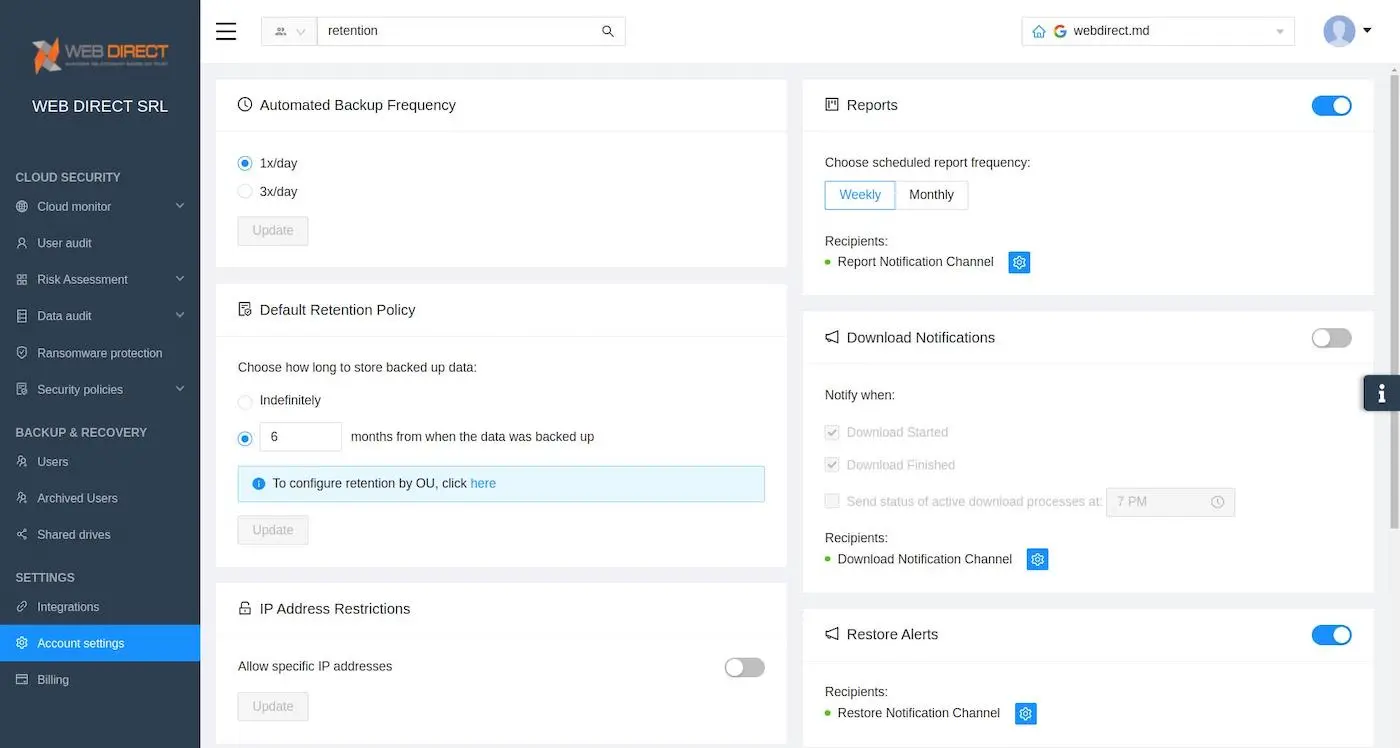
User Archiving
With SpinOne, Admins can archive users and keep their data for the mandated time span.
What are some common data retention policy issues?
Just like any company-wide plan, a data retention policy will present several serious challenges at both the planning and implementation stages. Let’s study the issues your team can meet.
Regulatory compliance pitfalls
Adhering to all the regulatory requirements is hard. However, the most difficult aspect is the lack of clarity in certain statutes. It is extremely difficult to incorporate them in your data retention policy.
For example, Health Insurance Portability and Accountability Act doesn’t stipulate the retention period for medical records.
Correctly categorizing the data
Arguably the hardest element of constructing the data retention policy, it’s difficult to comprehend and foresee what records your business will need one or ten years down the road.
To address your challenge, you need to consult with your legal division and heads of other departments. You can also look for industry policies and ask other companies about their practices.
Budget
The correct calculation of the expenditure on data retention can be problematic as it’s hard to predict the prices for tech stack and storage many years in advance.
‘Selling the idea’
If you are not the only approver of such changes, you might face some resistance when trying to introduce a data retention policy to the other decision-makers.
We suggest talking to your colleagues or managers about the value that data retention will bring to the company and to their individual performance.
Choice of data retention tools
In the abundance of solutions, what tools should your company choose? For digital data, we recommend looking for backups with archiving capabilities. Usually, such solutions charge less for archived users than collab tools like MSO 365 or Google Workspace.
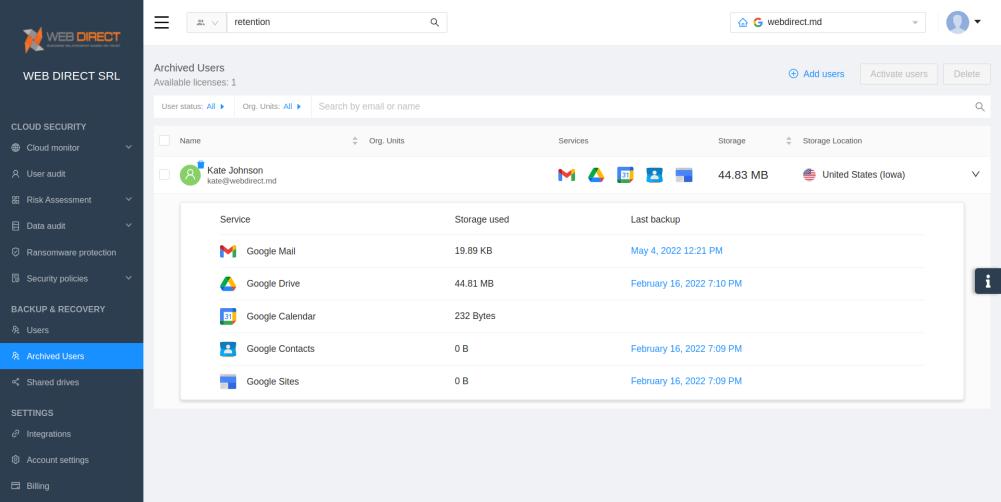
Proper Implementation
Implementing a data retention policy can be as hard as planning it. There will be employees and even teams who sabotage it simply because they see no value in it. There will be inevitable mistakes. Partially people will make it because your data retention policy is not perfect. Also, humans generally tend to make errors.
To handle this issue, we suggest several ‘cures’:
- Explain the necessity of the data retention policy to your employees.
- Encourage constructive criticism to eliminate mistakes.
- Revisit and redo your policy every once in a while.
- Automate as many data retention processes as possible..
Regular updating of the data retention policies
We talked about the necessity to revisit the policy periodically in the previous item on this list. Now, we’d like to focus more on it. Not updating the data retention policy is a regular mistake of many businesses. Meanwhile, the world around you is constantly changing. So is your organization.
The governments issue new regulatory requirements, and cybercriminals come up with new data breach techniques. Your company creates a new department, decides to produce new types of products or services, or launches a new project.
All these changes require new rules in your data retention policy. Secure that they get them.
Data retention policy examples
This section provides a data retention policy example in Microsoft Office 365. We’ll outline the basics, but for a more profound studying of the subject, please see this post.
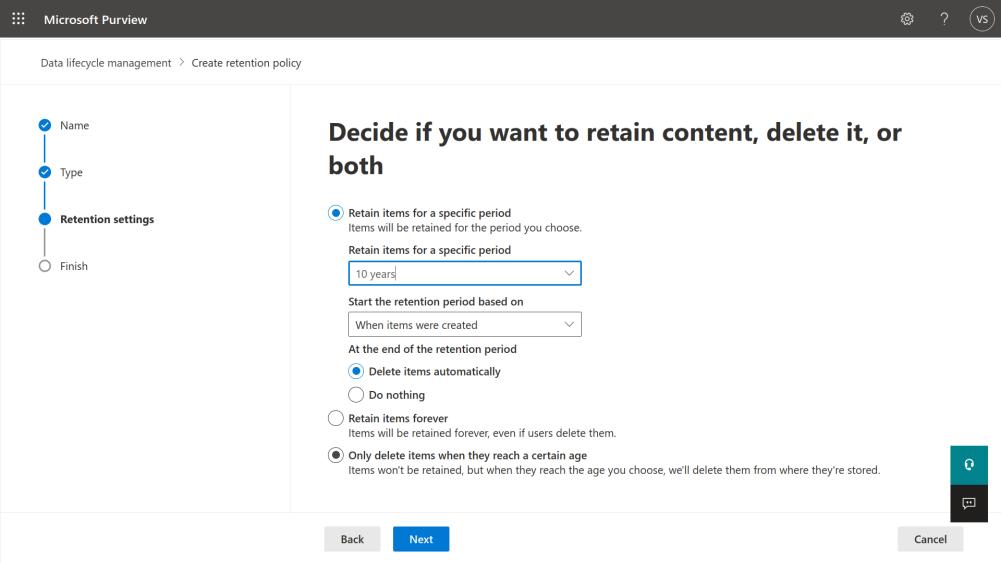
Features of MSO 365 data retention policy:
- The term of file preservation is long (up to permanent retention).
- Configure a data retention policy for a single employee and a single service (e.g., Onedrive).
- Designate the beginning of the data retention period from the doc creation or the last modification.
- Specify the deletion after the end of this policy or no action.
- No features to choose a certain type of data to be maintained exclusively (e.g. only documents or only files containing a certain word in the title).
- MSO 365 data retention policy cannot prevent deletions. It just duplicates a file that is subject to the policy and is erased.
Was this helpful?
How Can You Maximize SaaS Security Benefits?
Let's get started with a live demo
Latest blog posts
How to Restore A Backup From Google Drive: A Step-by-Step Guide
April 10, 2024Backing up your Google Drive is like making a safety net for the digital part... Read more
Protecting Partner Margins: An Inside Look at the New Spin.AI Partn...
April 2, 2024Google recently announced a 40% reduction in the partner margin for Google Workspace renewals –... Read more
Expert Insights: SaaS Application Data Protection Fundamentals
March 21, 2024SaaS applications appeal to organizations because they make running the application “somebody else’s problem.” However,... Read more

